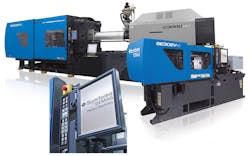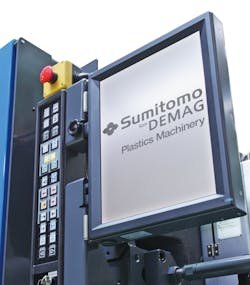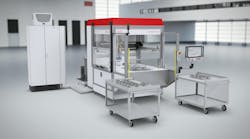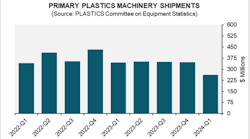By Bruce Adams
Sumitomo (SHI) Demag's NC5 plus controller, for its hybrid and hydraulic presses from Germany, and N10 controller, its all-electric presses from Japan, boast similar qualities, with a focus on ease of use and improving the injection molding process.
Related stories: Usability, artificial intelligence guide Engel's controller developments; Milacron controllers leverage data, iMFLUX capabilities; Arburg control features optimize molding process; Haitian targets Industry 4.0; Training helps Nissei customers maximize potential; Wittmann Battenfeld's B8 limits downtime, improves quality
“They are very similar strategies running on two different controllers,” said Tony Marchelletta, Midwest regional manager for Sumitomo (SHI) Demag Plastics Machinery North America. “We focus on precision, energy efficiency, ease of use, repeatability, lights-out operation and similar things that are vital for optimization.”
When developing machine controls, the company listens to what customers want and considers the direction the industry is heading.
“Customers don’t want to have to worry about a number of different interfaces to get their robot and their hot runner talking to their machine and the mold temp units,” said Marchelletta, who has been with Sumitomo Demag for 10 years and in the plastics industry since the mid-1990s. “They want us to make it easy for them. We are getting a lot more requests for plug-and-play interfaces and solutions. Parallel to that are more integrated monitoring solutions, so it is easy for them to network our machine into their plant networks or even to their manufacturing facilities around the world.”
The company has a zero-molding strategy where it tries to drive to zero defects, flaws and downtime.
Customers want a control and machine that are easy to learn and use.
“We have very quick, easy to follow, step-by-step mold set guides,” Marchelletta said. “Even if they haven’t worked with our control that much, they can go to this one page and it will walk them through step by step exactly how to get going and what to do next. They don’t have to fumble through 10 or 12 pages trying to find a button or a setpoint. Everything is very clear, concise and methodical to get the process running.”
Users can enter some basic information and follow the control’s leads.
“We’ve built in some suggested setpoints, so a customer can put in their material type and a little basic information about the process and the machine control will make some suggestions for critical setpoints,” he said. “It might not be 100 percent optimized, but it will point them in the right direction and make the fine-tuning of the process easier.”
The company offers slightly different connectivity solutions depending on what customers want to do.
Sumitomo’s portfolio of production monitoring solutions that provide remote access includes I-Connect for all-electric machines and myConnect for hybrid and hydraulic machines.
“They are very similar strategies. They both tie machines together and give you remote access,” he said. “In the future, they will become the same package. But for now, they are running on two slightly different control systems, so we branded them separately.”
The NC5 plus and N10 controllers are on the cusp of Industry 4.0 functionality.
“The driving force of Industry 4.0 is coming out of Europe primarily, so our NC5 plus is a step ahead of the other control system,” Marchelletta said. “It is on its way, if not considered, an Industry 4.0-compliant-type control system. The N10 could be there with some optional content. We could add Euromap interface protocols for communication to the N10. It depends on what the customer wants and needs. We can equip either controller to get there.”
Plant infrastructure often is a missing link that’s required for Industry 4.0.
“The machine can effectively hook to anything,” he said. “But many times, the plant network is not set up for an entire fleet of machines to be plugged into it and communicating with it and pushing data back and forth. We are waiting a little bit on the customers to catch up — to get their infrastructures in place. From there, we can decide what types of interfaces we need on the machine and what type of communications protocols.”
The next generation of controls will facilitate plug-and-play operation and incorporate more auxiliary equipment interfaces, he said.
“That will make it easier to set up everything from a single screen or while doing it remotely through a hub in the machine that everything ties into,” Marchelletta said. “Everybody is trying to get to that level.”
In addition, more materials that have very demanding processing requirements will influence development.
“That could be very high injection pressures or very fast injection rates,” he said. “It is driving us to push the bounds to go faster, to have higher pressures, to have longer hold times and to open process windows for customers to optimize their process control.”
Bruce Adams, senior staff reporter
Contact:
Sumitomo (SHI) Demag, Strongsville, Ohio, 440-876-8960, www.sumitomo-shi-demag.us








